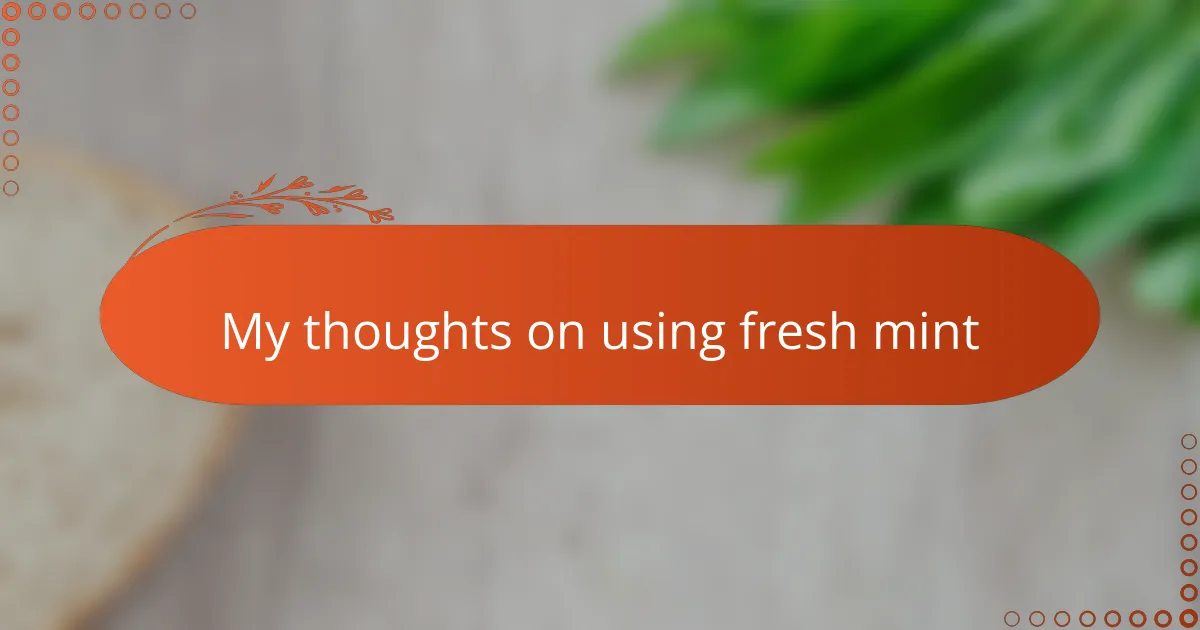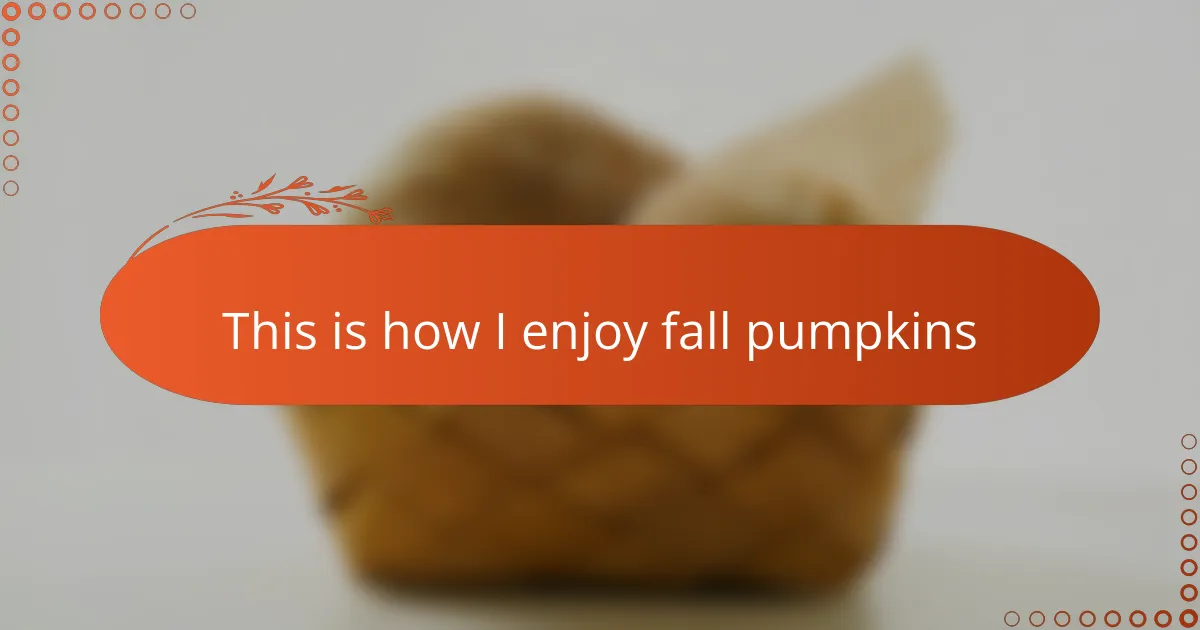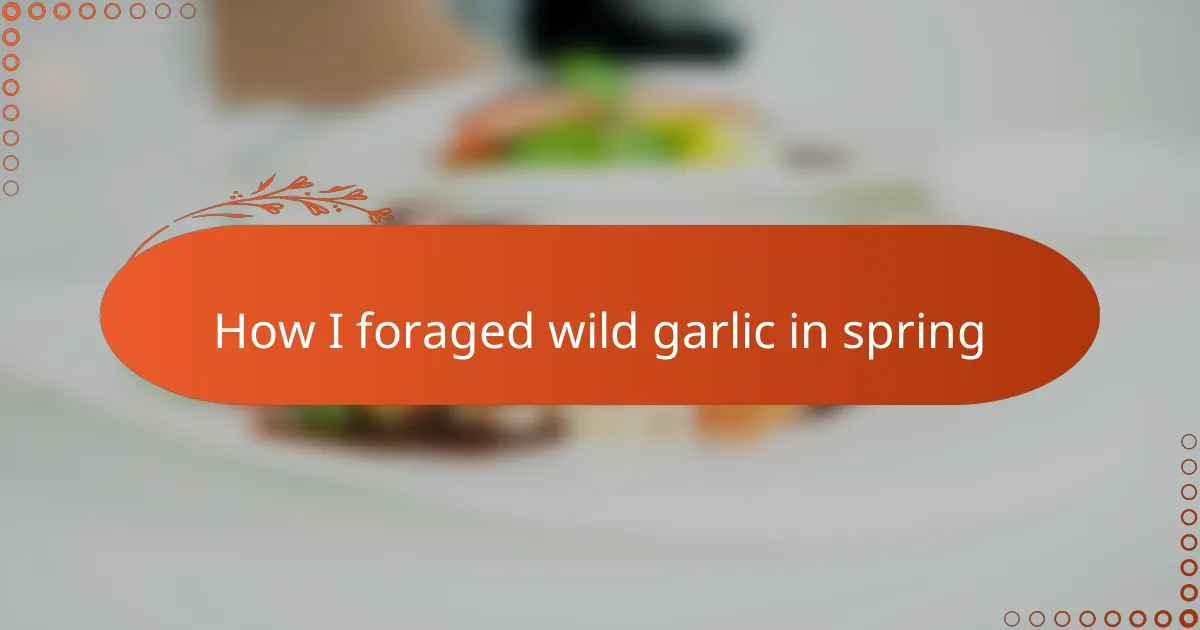Key takeaways
- Fresh mint aids digestion and enhances the flavor of dishes, making it a valuable ingredient in cooking.
- Choosing vibrant, tender mint leaves and sourcing them from your garden or local farms ensures optimal flavor and health benefits.
- Growing mint requires careful management to prevent it from overtaking other plants, with a preference for a mix of sunlight and shade.
- Creative uses for fresh mint include infusing beverages, adding to salads and baked goods for unexpected flavors.
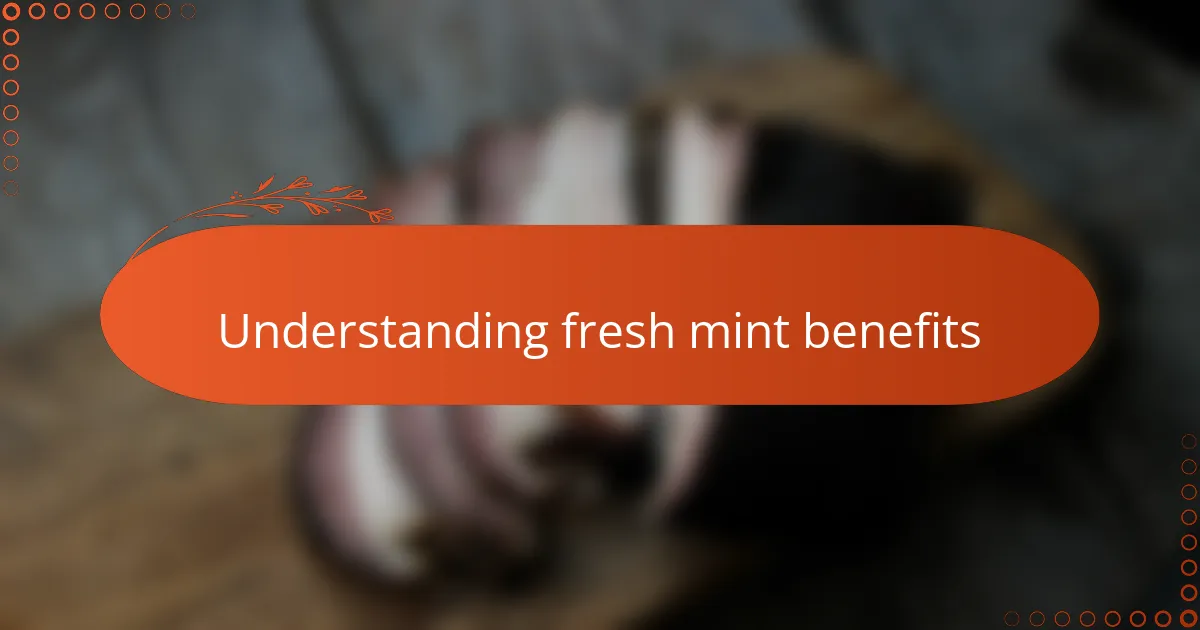
Understanding fresh mint benefits
Fresh mint has always been my little kitchen hero, not just for its vibrant aroma but for its impressive health perks. Did you know it can aid digestion and soothe an upset stomach? I’ve found that adding a few leaves to my herbal teas often brings a calming comfort that feels almost therapeutic.
I vividly remember the first time I used fresh mint straight from my own garden. The burst of cool flavor was so refreshing—it turned a simple dish into something memorable. It’s this natural freshness, packed with antioxidants and vitamins, that makes me appreciate mint beyond just a garnish.
Have you ever wondered why mint is such a popular ingredient in so many homesteading recipes? To me, it’s the perfect blend of taste and health benefits, offering both flavor and nourishment in one small leaf. That kind of versatility is a game-changer in the kitchen.

Choosing fresh mint for homesteading
When it comes to choosing fresh mint for homesteading, I always reach for leaves that look vibrant and feel tender to the touch. Have you noticed how the best mint has that unmistakable bright green color and a fragrant, almost sweet scent? Picking mint this way makes all the difference in flavor and aroma.
I once made the mistake of using dull, limp mint from the store, and the difference was striking—I missed that lively, invigorating punch that fresh, homegrown mint delivers. Since then, I’ve become very picky, especially because growing mint myself means I can harvest exactly when it’s at its peak. There’s a special satisfaction in knowing the mint on my plate was just minutes ago in my garden.
Choosing fresh mint also means considering where it’s grown. I prefer mint from my own garden or a trusted local farm because I want to avoid any pesticides or chemicals. Do you ever wonder about the journey your herbs take before they reach your kitchen? For me, sourcing mint carefully is part of loving the food I create.
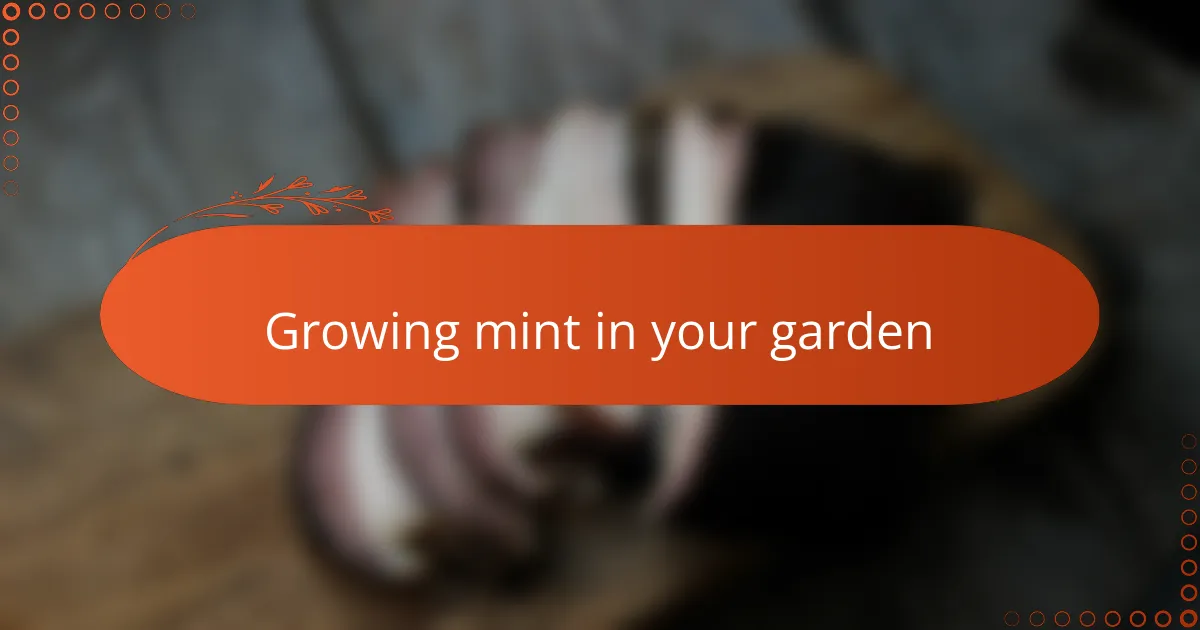
Growing mint in your garden
Growing mint in your garden has been one of the simplest joys I’ve experienced in homesteading. I remember planting my first mint runner in a small, sunny corner, and within weeks, it transformed that spot into a lush, fragrant patch that I couldn’t help but check daily. Have you ever noticed how quickly mint spreads? It’s almost like it has a mind of its own—a bit like having a lively, green companion that keeps you company in your gardening routine.
One thing I learned early on is that mint thrives best when contained. Without a barrier, it can quickly take over other plants, turning your carefully planned garden into a wild mint jungle. That discovery taught me the importance of using pots or dedicated garden beds, which helped me enjoy an abundant harvest without losing control.
Another tip from my experience: mint loves a mix of sunlight and shade, so I found placing it where it gets morning sun and afternoon shade really keeps the leaves vibrant and healthy. Have you tried experimenting with your garden’s microclimates to see what your herbs prefer? For me, this small adjustment made all the difference in growing fresh mint that feels alive and ready to flavor every meal.
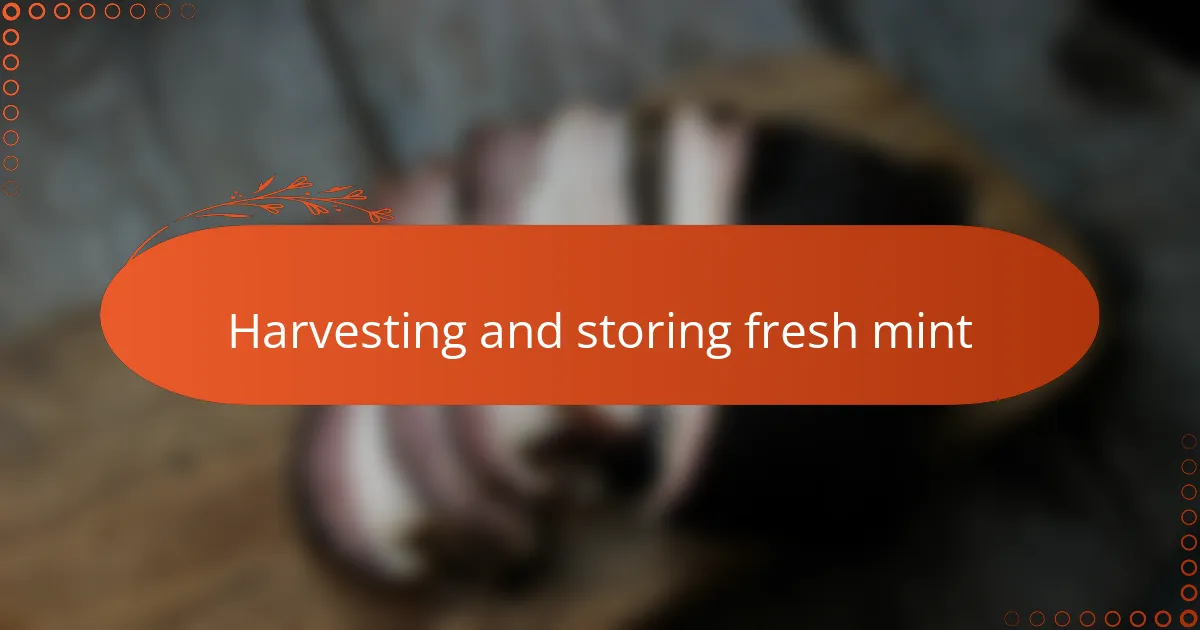
Harvesting and storing fresh mint
Harvesting fresh mint is something I approach with a gentle touch, always snipping the stems just above a set of leaves. Have you ever noticed how doing this encourages the plant to become bushier? It’s like giving your mint a little haircut that rewards you with even more leaves to enjoy.
Storing mint properly has saved me from many a wilted disappointment. I like to keep the stems wrapped in a damp paper towel inside a plastic bag in the fridge—it keeps the mint crisp and fragrant for up to a week. Have you tried this? It feels like preserving a little piece of your garden’s freshness even when you’re not outside.
Sometimes, when I have a surplus harvest, I freeze mint leaves in ice cube trays with a splash of water or olive oil. This trick has been a game-changer for me, especially in winter months when fresh greens are scarce. Don’t you love having that burst of garden-fresh mint ready to drop into a stew or salad, even off-season?
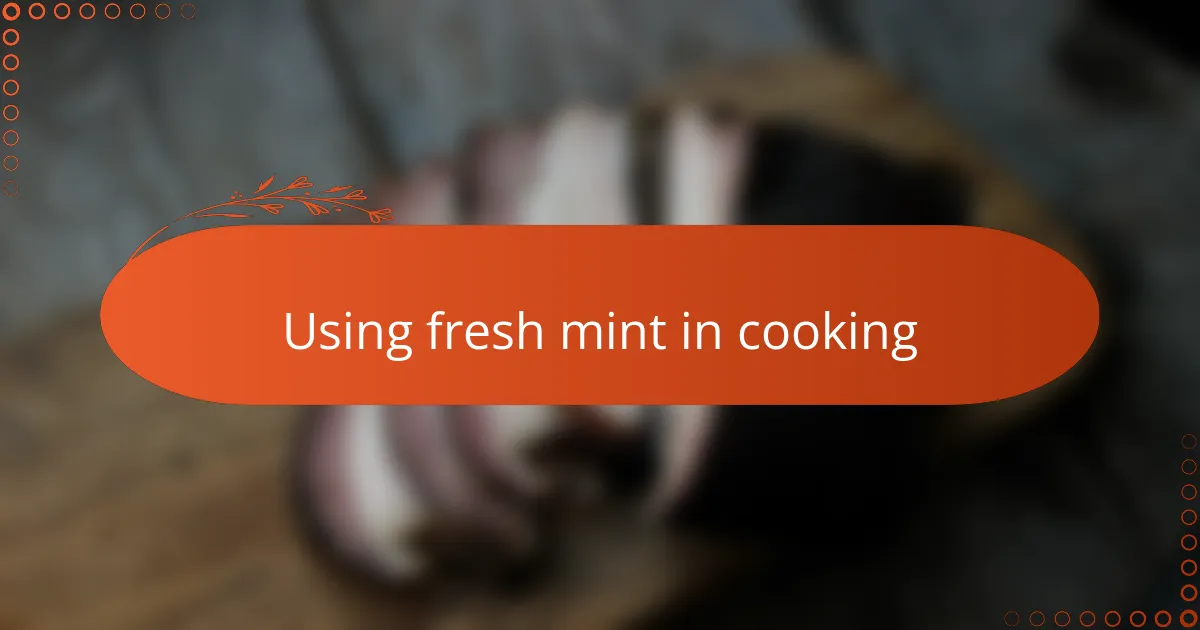
Using fresh mint in cooking
Using fresh mint in cooking always brings a certain brightness to my dishes that dried herbs just can’t match. Have you ever sprinkled freshly chopped mint over a warm lamb stew or tossed it into a crisp cucumber salad? That cool, slightly sweet freshness lifts the entire dish, making simple meals feel special.
One of my favorite ways to use fresh mint is in homemade sauces and marinades. For instance, blending mint with garlic, lemon juice, and olive oil creates an easy, vibrant dressing that not only flavors grilled vegetables but also adds a refreshing zing to grain bowls. It’s amazing how a handful of mint leaves can transform everyday ingredients into something extraordinary.
Sometimes, I get a little adventurous and add fresh mint to desserts—like mint-infused syrups poured over berries or stirring it into whipped cream. The subtle herbaceous note balances sweetness so well, don’t you think? It’s these small touches of fresh mint that keep me excited about cooking from my homestead garden.
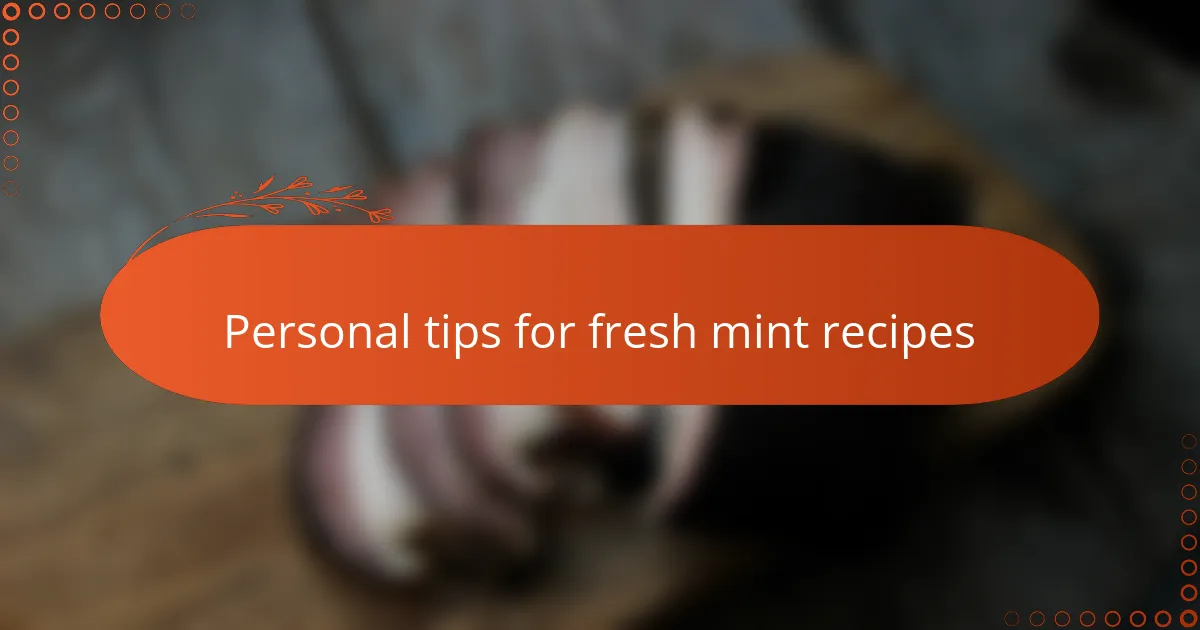
Personal tips for fresh mint recipes
When I’m cooking with fresh mint, I’ve learned that adding it at the very end makes all the difference. Have you ever noticed how cooking mint too long can dull its vibrant flavor? I always spare those last-minute sprinkles to keep that refreshing brightness alive in the dish.
I like to tear mint leaves by hand instead of chopping them finely. Somehow, this small ritual seems to release the essential oils more gently, giving the recipe a softer, more natural mint aroma. Have you ever tried this simple technique? It’s a subtle change, but it really deepens my connection to the ingredients I use.
One tip that often surprises people is using fresh mint in unexpected pairings—like stirring it into cooked grains or mixing it with roasted root vegetables. It might sound odd, but that gentle minty note can bring surprising freshness. Do you experiment like this in your kitchen? For me, it’s these little surprises that keep cooking with mint endlessly exciting.

Creative fresh mint recipe ideas
One of my favorite creative ways to use fresh mint is in infused beverages beyond the classic mint tea. Have you ever tried adding a few mint leaves to homemade lemonade or iced water? That simple addition transforms a basic drink into something unexpectedly refreshing, perfect for lazy summer afternoons on the homestead.
I also enjoy experimenting with mint in salads, but not just any salad—think roasted beet and orange salad with a sprinkle of chopped mint. The interplay of sweet, earthy, and zesty flavors feels so lively. Have you noticed how fresh mint can brighten even the most humble vegetables? It’s like a little burst of garden sunshine on your plate.
Sometimes, I get playful with mint in baked goods, like folding finely chopped leaves into a lemony scone batter. That subtle herbaceous hint balances the sweetness beautifully. Can you imagine the delight of biting into a warm scone that’s both comforting and refreshingly unexpected? For me, these creative touches are where fresh mint truly shines in homesteading cooking.
